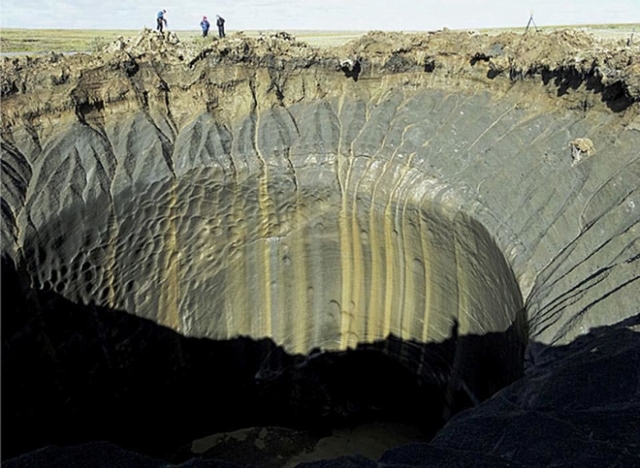
-
Siberia’s Exploding Craters Have Scientists Mystified [Video]
08 Jun 2023 by Heinrich in Tech/Sci, Video, World
[imagesource:youtube/bbc]
Massive holes are exploding into existence on a remote peninsula in Siberia, and while scientists think they understand the phenomena, they aren’t really sure what this means for the rest of the world.
To date, 17 of these massive holes have appeared in the permafrost, and scientists are flabbergasted and worried about how quickly they happen. Recent research, however, is now starting to provide some clues about what might be going on.
As the blast occurs, blocks of soil and ice are thrown hundreds of metres from the crater and according to Evgeny Chuvilin, a geologist at the Skolkovo Institute of Science and Technology “We are faced here with a colossal force, created by very high pressure. Why it is so high still remains a mystery.”
That holes are all about 20m wide and up to 52m) deep and were first discovered by helicopter pilots passing overhead in 2014. Scientists describe it as an ‘entirely new feature in permafrost’ and analysis of satellite images later revealed that the crater – now known as GEC-1 – formed sometime between 9 October and 1 November 2013.
Exactly what is causing these enormous holes in the permafrost to appear and how suddenly they form is still largely a mystery. The clever people compare them to cryovolcanoes found on other solar system bodies such as the icy moon Titan, or Pluto. The ice-volcano erupts with incredible force and sends ‘ice-lava’ spewing hundreds of metres into the air.
What is really weird about these holes is their perfectly round and clean shapes. This in itself lends a clue to their origins. Unlike other permafrost features, these don’t occur due to gradual subsidence as the permafrost melts and shifts below the surface. These holes explode outward, and have been slowly gaining a reputation as ‘gas-emissions craters’.
[image:flickr]
Analysis based on satellite imagery shows that a blast makes a giant hole in the place of a mound as usually happens when a layer of frozen ground is pushed up by water that has managed to flow underneath it and started to freeze. But these ‘normal’ mounds tend to eventually collapse in on themselves rather than explode.
It is clear that the mounds in north-west Siberia are behaving differently. They swell “very fast, rising to several metres” before they blow their top suddenly.
Sounds like a frozen pimple. Something about the permafrost in this peninsula, however, makes it prone to these exploding mounds.
A recently discovered hole appears to have formed on the spot of a dried-up lake. When the lake vanished, it left behind an unfrozen patch of soil beneath it where gas then built up.
The origin of the gases is, however, a mystery because once the crater erupts, the gas disappears and leaves little for scientists to work with, except a big-ass hole. The force is so great that blocks of earth up to 1m across are thrown up to 300m outwards, leaving a crater with a wide mouth and a narrower cylindrical hole. Some reindeer herders have even reported seeing flames and smoke shoot out from the area where a hole appeared.
At this stage of their research, scientists however don’t know if this poses a threat to the surrounding villages in this area, but I would consider random explosions followed by a gateway to hell a threat if there ever was one.
Check out the BBC video below for a more detailed look at these natural anomalies that are baffling scientists.
Thank goodness we live in such a stable part of the Earth.
[source:bbc]
Latest News
-
Thai Woman Sentenced To Death For Murdering 14 Friends With Cyanide In Shocking Killing Spree
[imagesource: Sararat Rangsiwuthaporn] A woman in Thailand, dubbed 'Am Cyanide' by Thai...
-
René Magritte Painting Sells For Record R2.1 Billion At Auction
[imagesource:renemagritte.org] A René Magritte painting portraying an eerily lighted s...
-
Brave Rape Survivor Alison Botha Faces New Challenge After Brain Surgery
[imagesource: Alison Botha] Gqeberha rape survivor Alison Botha, a beacon of resilience...
-
Get Ready For The Mother of All Celebrations As MCQP Turns 30
[imagesource:mcqp/facebook] Clutch your pearls for South Africa’s favourite LGBTQIA+ ce...
-
The Iconic Good Hope Centre Is Set For Redevelopment
[imagesource:capetown.gov] The City of Cape Town’s Mayoral Committee has approved the...
-






























